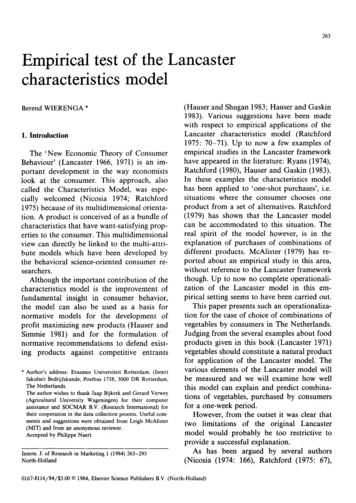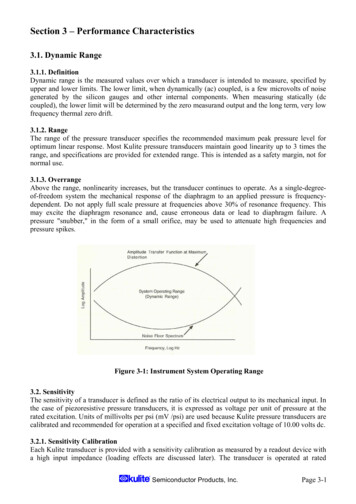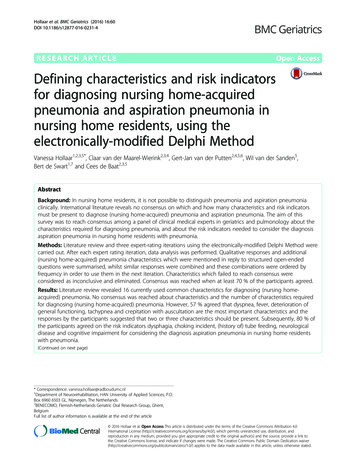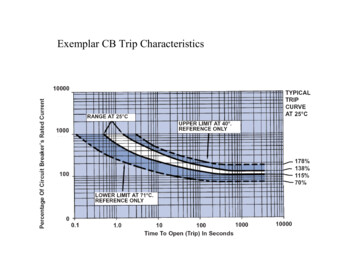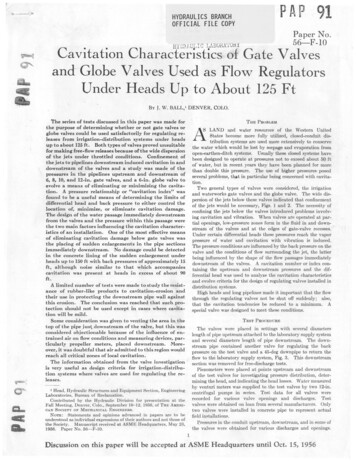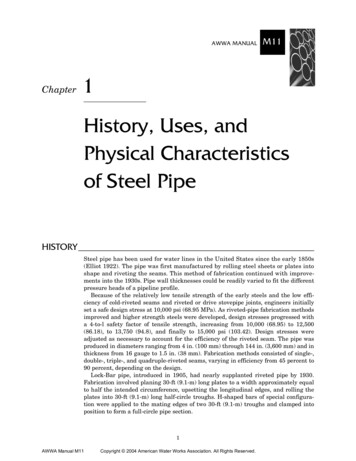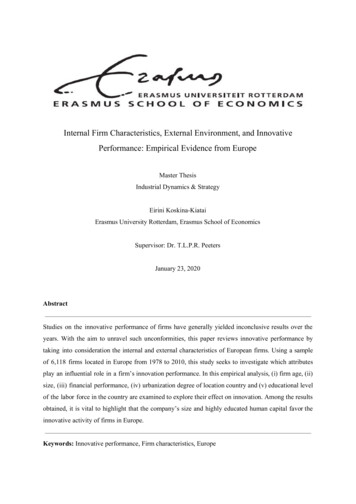
Transcription
Internal Firm Characteristics, External Environment, and InnovativePerformance: Empirical Evidence from EuropeMaster ThesisIndustrial Dynamics & StrategyEirini Koskina-KiataiErasmus University Rotterdam, Erasmus School of EconomicsSupervisor: Dr. T.L.P.R. PeetersJanuary 23, 2020AbstractStudies on the innovative performance of firms have generally yielded inconclusive results over theyears. With the aim to unravel such unconformities, this paper reviews innovative performance bytaking into consideration the internal and external characteristics of European firms. Using a sampleof 6,118 firms located in Europe from 1978 to 2010, this study seeks to investigate which attributesplay an influential role in a firm’s innovation performance. In this empirical analysis, (i) firm age, (ii)size, (iii) financial performance, (iv) urbanization degree of location country and (v) educational levelof the labor force in the country are examined to explore their effect on innovation. Among the resultsobtained, it is vital to highlight that the company’s size and highly educated human capital favor theinnovative activity of firms in Europe.Keywords: Innovative performance, Firm characteristics, Europe
Table of ContentIntroduction2Literature Review4Internal Firm Characteristics5Innovation and Firm’s Age5Innovation and Firm’s Size7Innovation and Financial Performance8External Firm CharacteristicsInnovation and Degree of UrbanizationInnovation and Country-Level of EducationData Description & Methodology991011Sample Construction11Variable Description12Methods15Results17Analysis of the Internal Characteristics that Influence Innovative Performance17Analysis of the External Characteristics that Influence Innovative Performance20Concluding Remarks22Limitations & Future ist of TablesTable I: Variable Description12Table II: Descriptive Statistics15Table III: Correlation Matrix for Firm-Level Model31Table IV: Correlation Matrix for Country-Level Model32Table V: Hausman test for Firm-Level Model33Table VI: Hausman test for Country-Level Model33Table VII: Innovative Performance and Internal Firm Characteristics17Table VIII: Innovative Performance and External Firm Characteristics20Erasmus School of Economics 1
1.Introduction“Innovation” seems to be everywhere you lay your eyes these days. Everybody is eager to find moreefficient products and services that save precious time and cost. Firms implement a proliferation ofinnovative business models and methods of production, in their attempt to be at the forefront of theevolution and adopt an innovative image for their customers (Fagerberg & Verspagen, 2009).Policymakers also focus on innovation by engaging many actors of business, academia, andgovernment to create network effects, knowledge spillovers, and clusters that will foster the growth ofthe country and attract the very best innovators (Agarwal et al., 2007; van Winden et al., 2014). Yet,do we really know what innovation is? A large body of literature has appeared due to this emergingpopularity, with scholars trying to understand the many aspects and forms of innovation (Fagerberg,2004). But probably, no one could give a better explanation of innovation than its prophet, JosephSchumpeter (McCraw, 2009). In his work, Schumpeter (1934) described innovation as a disruptivesource of energy that brings economic and social change.How is innovation leveraged might someone wonder. Extensive literature in the past hasidentified the main drivers of firms’ innovative capacity and even further, innovation’s significancefor economic development (Schumpeter, 2017). In this paper, these drivers are conceptualized asorganizational characteristics that apply to any firm, regardless of the business sector or multinationallocation. More specifically, this research emphasizes the basic features that every company carries,such as the age, size, and level of financial performance. In this way, this study avoids the risk toexclude smaller companies that lack the research and development department, even though itscontribution to innovation is undoubtedly accepted. Yet, apart from firms, countries have a primaryrole in innovation. Previous work by Fagerberg and Srholec (2008) has shown that differences incountry innovativeness explain differences in country development. Unambiguous is also theimportance of human capital to innovation ( Dakhli & De Clercq, 2004; Lund Vinding, 2006). ForErasmus School of Economics 2
example, it is acknowledged that the educational level of a country is highly related to the country’sproductivity and development. For this reason, this paper also focuses on the external attributes of thebusiness environment that are impacted by the country’s policy. In particular, this empirical worktakes into account the urbanization degree of different European countries to unveil the importance ofcountry characteristics in firm innovativeness.Still, how important is it to measure innovative activity? What is the impact of innovation at asocietal level and what at a firm level? It seems that previous literature agrees on the fundamental roleof innovation at both these levels. At the macro level, Agarwal et al. (2007) developed a frameworkthat recognizes innovation and spillovers as a leveraging mechanism that generates new ventures andeconomic growth. Moreover, innovation has been identified as a key factor behind the conversion ofsocial capital into higher welfare (Akçomak & Ter Weel, 2009). Rodríguez-Pose and Crescenzi(2008) highlighted the importance of geography for European regions in this growth performance.They found that the proximity of countries contributes highly to the flow of tacit knowledge andtechnological spillovers. Apart from being one of the major drivers of economic development(Tushman, 1997), innovation is a vital component of growth at the micro-level (Rosenbusch et al.,2011). According to literature, taking into account that every firm has limited resources, firms willhave to enhance their abilities to better evaluate, integrate and convert external knowledge into newproducts and services (Stock et al., 2001). This ability is called “absorptive capacity” in the literatureand it is highly dependent on innovative capacity (Cohen & Levinthal, 1990). Absorptive capacity is akey driver for every organization that wants to sustain a competitive advantage against rivals (Zahra &George, 2002), and it differs according to each kind of knowledge that is absorbed by differentinnovation activities ( Schmidt, 2010) . Hence, absorptive capacity seems to be a crucial element of anyfirm’s behavior, regardless of its innovation propensity.Given the fundamental significance of innovation, both on a societal and business level, theresearch questions that this study explores are: What are the characteristics of firms that attain betterinnovative performance? Are these characteristics found in the internal or external environment ofErasmus School of Economics 3
firms? The purpose of this research is to identify the attributes of the firms with more enhancedinnovative performance in Europe. With this objective, this study uses a sample of 6,118 Europeancompanies with patents in the U.S. Patent and Trademark Office and performs an analysis ofcharacteristics from both their internal and external firm environment. In particular, it examines theeffects of the firm’s age, size, and financial performance, as well as the urbanization degree of thecountry that is located in Europe, on the firm’s innovative capacity. Moreover, the national educationlevel is further analyzed to reveal the effect on firm innovativeness. The findings of this workconstitute a contribution to the field by offering a detailed explanation of more innovativeorganizations in Europe. In addition, this study yields significant business knowledge for theresource-based theory (Newbert, 2007), because it avails firms to recognize the appropriate elementsto implement a successful strategy in order to achieve higher innovative performance.The remainder of this paper is structured as follows. First, the theoretical perspectives thatlead to the formulation of the hypotheses are reviewed. Next, the data and methodology used for thisresearch are described. Then, the findings of the paper are analyzed and interpreted. Finally, theconclusion, possible limitations, and recommendations for future research are presented.2.Literature ReviewThe notion of innovation has been studied in the past by several scholars and its importance onbusiness performance is unambiguous (Hult et al., 2004). It has been highlighted as the source ofcompetitiveness and profitability (Prajogo & Ahmed, 2006). However, this argument holds only whenthe commercialization of innovation results in successful innovative performance. Hence, it is vital tounderstand the meaning of the term “innovative performance” and its measurements.In previous literature, innovative performance has been determined by the percentage of theintroduction of new products or services or the improvement of the existing ones on total sales of theErasmus School of Economics 4
organization during the last three years (Caloghirou et al., 2004). Therefore, it is essential to take intoaccount the management capabilities of the firm to successfully commercialize innovation in themarket (Protogerou et al., 2017), rather than just the ability to value and apply knowledge. However,previous scholars have emphasized that the idea of an innovative organization is not identical to itssuccessful innovative activities. On the contrary, there are different types of innovative organizationsthat innovate in various ways and commercialize inventions differently (Damanpour & Wischnevsky,2006). Thus, this is not what this paper examines.This study measures innovative performance using the widespread approach of Acs et al.(2002), namely to measure innovative capacity with the use of patent counts. According to their work,using this instrument allows this paper to fairly represent innovative activity. Yet, it would be fair tomention other measures of innovative activity identified in the literature. Another instrument that hasbecome a measure to capture innovative performance is patent citations. Moser (2013), however,pointed out that this approach might give a biased picture of innovation for developing countrieswithout patent legislation or for countries that are below the technology frontier. An alternative tomeasuring innovative activity is through innovation surveys (Archibugi & Planta, 1996). Althoughthis measure sounds more relevant than the previous ones, it still has its downside. For example, thedefinition of “innovation” might differ from country to country or the interpretation of the findingsmight vary depending on different cultural backgrounds and managerial overestimations (Fagerberg,2004).2.1.Internal Firm Characteristics2.1.1.Innovation and Firm’s AgeWhile many scholars have emphasized how innovative performance alters with age, others havefocused on how age affects the way in which firms gain from innovation. In fact, in the literature firmage is considered both favorable and detrimental to innovative performance (Sørensen & Stuart,Erasmus School of Economics 5
2000). One the one hand, older organizations have the advantage of learning effects, i.e. mature firmsinnovate more efficiently as they build on a previous solid basis of knowledge and capabilities (Zahra& George, 2002). In the long-term, older firms tend to innovate on the basis of existing routines,resources and competencies and are able to handle uncertainty better than younger firms. That isbecause older organizations engage in incremental innovation by undertaking less risky projects alongwith a more diversified portfolio of innovative projects. This assists to achieve a reduction in theuncertainty of the R&D investments. Still, older firms suffer from the phenomenon of organizationalinertia that restrains the organization to deviate from routine and change (Sørensen & Stuart, 2000).On the other hand, as early-stage companies are associated with less organizational inertia, itis expected that entrant companies are more prone to the probability of innovating (Huergo &Jaumandreu, 2004a). In other words, they must be having high-level innovation capabilities thataccording to Agarwal (1998), are related to their survival. From this perspective, it is estimated thatcompanies who attain a better performance from the adoption of innovations are young and apt toinvest in R&D (Coad, Segarra & Teruel, 2016). Furthermore, living in an e-world has contributed toyounger and smaller firms being on equal footing with larger firms in terms of obtaining externalknowledge and online global recognition (Houghton, & Winklhofer, 2004). Last but not least, thepropensity of newborn firms to undertake radical innovation generates an even stronger effect on firmproductivity growth (Huergo & Jaumandreu, 2004b). Following the same line of reasoning with thelatter authors, the first hypothesis is formed as follows:Hypothesis 1 : Older firms file, ceteris paribus, fewer patents than younger firms.Erasmus School of Economics 6
2.1.2.Innovation and Firm’s SizeA further characteristic underlined by traditional literature is the organizational size. With respect tothe two Schumpeterian theories on firm size and innovation, this is a topic that stirs up controversy.Considering the first vision of Schumpeter, i.e. innovation comes from small firms, a lot of argumentshave been raised praising this notion. To begin with, Damanpour (1991), among others, studied therelationship between the determinant of size and organizational innovation and found that smallenterprises have been shown as more innovative. In fact, he observed that smaller firms are moreflexible and dynamic, and therefore less risk-averse to innovation. On the same page, other authorshave noticed that smaller firms may be more alert to new opportunities ( Rogers, 2004) . Since smallerorganizations lack strict lines and structures, they are more easily adaptable to changes and open torevolutionary ideas. Other scholars like Agarwal and Audretsch (2001) have found that small sizeenterprises can be equally strong as larger firms especially when their entrance to the industry is aresult of tackling unseen opportunities, by larger firms, for market niches.Opponents of this view are supporters of Schumpeter’s later argument, i.e. innovationeventually comes from large firms, which was his concluding view on the relationship between firmsize and innovation. According to this view, large firms own the necessary funds and skilled humanresources to accumulate and exploit the knowledge that leads to innovation, through intensive R&D(Acs & Audretsch, 1988). As mentioned above, high levels of absorptive capacity of larger firms havea direct effect on innovative activity (Kostopoulos et al., 2011). Indeed, the existence of a positive andsignificant relationship between organizational size and innovative performance is confirmedrepeatedly in the literature ( Camisón-Zornoza et al., 2004). Another characteristic of big, establishedcompanies is the advantage of economies of scale that allow them to spread the costs of innovationover a larger base and avoid sunk costs (Symeonidis, 1996). Overall, it seems that innovative activityis more influenced by better infrastructures of large firms that possess the appropriate assets to captureErasmus School of Economics 7
important knowledge and commercialize innovation successfully. According to the arguments above,the following hypothesis seems to be supported:Hypothesis 2 : Larger firms file, ceteris paribus, more patents than smaller firms.2.1.3.Innovation and Financial PerformanceEven though prior research explores all the benefits of innovative capacity to firm financialperformance in depth, finding that firms with good financial performance tend to file more patents(Geroski et al., 1993; Kostopoulos et al., 2011;), only a few empirical studies examine the effect ofprofitability on innovative performance (Bhattacharya & Bloch, 2004). Superior economicperformance is unambiguously a great advantage for overall enhanced firm performance in terms ofcompetition and recognition, however, is it considered a determinant of innovative capacity? Takinginto consideration that innovative capability requires the enhancement of employee skills, continuousdevelopment of operations, and improvement of exploiting external networks, it is therefore expected,that successful financial performance is essential. One of the few studies on this matter, conducted byAudretsch (1995), showed that there is a positive and significant relationship between profitability andinnovative activity but under the regime of high-tech industries. The present study extends thisprevious work by examining the effect of the financial performance of European firms from a varietyof industries on their innovative performance. Thus, a third hypothesis is now suggested:Hypothesis 3 : Financially successful firms file, ceteris paribus, more patents than less profitablefirms.Erasmus School of Economics 8
2.2.External Firm Characteristics2.2.1.Innovation and Degree of UrbanizationA high degree of urbanization is interwoven with European civilization. The idea of urban areas isdeeply connected with the concepts of superior infrastructure, accessibility and labor mobility. Thisperspective is consistent with the perception of Antrop (2004) who indicated that innovation diffusedrapidly in European cities. As already mentioned, there is a strong and significant linkage betweeneconomic development and urbanization in Europe (Akçomak & Ter Weel, 2009). From the historicalpast of Europe, urbanization constituted an instrument influencing economic growth since it leveragedentrepreneurial activity. Until today, it seems that entrepreneurs are drawn to urban regionalcharacteristics. In his work, Fritsch (2013), studied that urbanization economies foster knowledge,innovative activity, and technological evolution. According to his approach, urban agglomerationeconomies complement innovation by spillover effects. Evidence from several other studies (Van derPanne, 2004; Agrawal et al., 2008) reports the existence of strong knowledge spillovers due togeographic proximity. Taking into account that these clustering externalities cherish entrepreneurialand innovative activity, it is therefore suggested that urbanization economies complement innovation.In other words, the concept of the location has been found to be critical for innovation(Feldman, 1999; Audretsch & Feldman, 2004). More specifically, urban regional characteristics seemto attract dynamic entrepreneurial movement due to all the advantages they offer to the human capital(Moretti, 2004). Accordingly, firms enjoy large benefits owing to the employment density in cities,and therefore, the growth productivity that it delivers. Moreover, Jaffe et al. (1993) discovered animportant indirect effect between localization and innovation. In fact, they found that the knowledgespillovers that occur in urban economies increase the patent citations of firms located in these areas.Given the discussion above, the following hypothesis is proposed:Erasmus School of Economics 9
Hypothesis 4 : Firms located in countries with high urbanization degree file, ceteris paribus, morepatents than firms located in countries with lower urbanization degree.2.2.2.Innovation and Country-Level of EducationMany scholars in the past have linked education with economic development (Hanushek &Wößmann, 2007; Pillay, 2011). First, it is commonly alleged that increases in education bring an evenhigher return on human capital (Moretti, 2004). Second, a higher level of human capital results ineconomic growth through increases in GDP per capita, respectively. What might n
Studies on the innovative performance of firms have generally yielded inconclusive results over the years. With the aim to unravel such unconformities, this paper reviews innovative performance by taking into consideration the internal and e

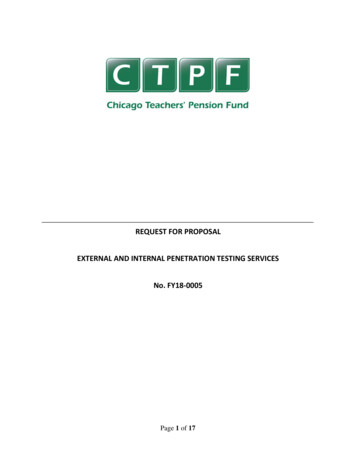
![03[1] Analysis of the Internal Environment](/img/2/031-analysis-of-the-internal-environment.jpg)

